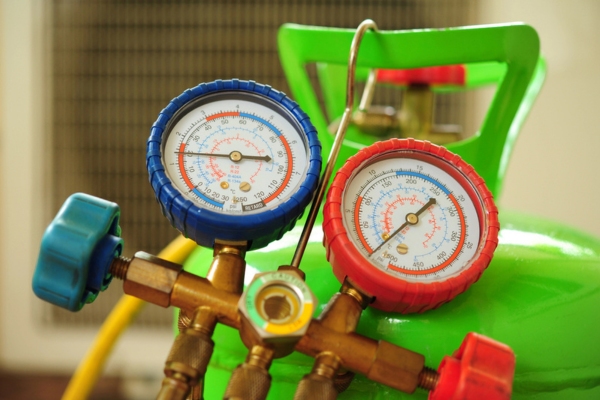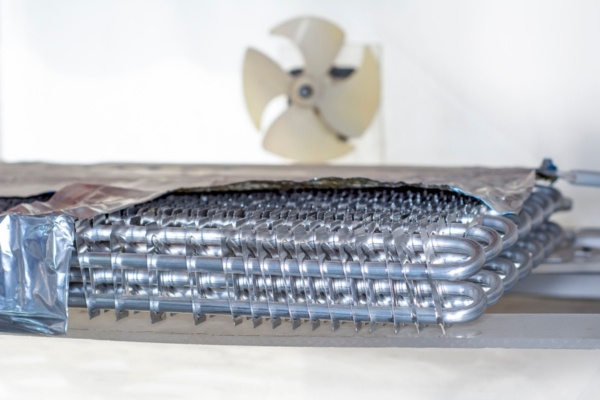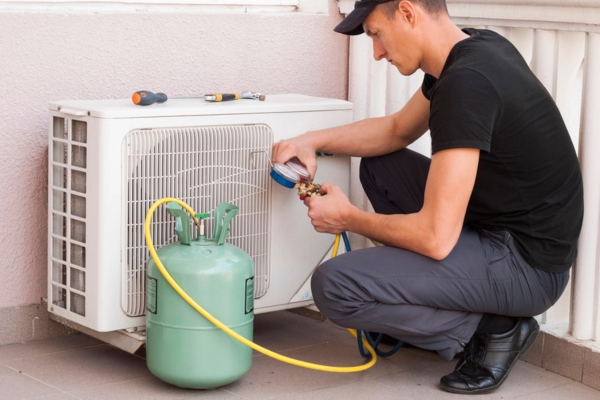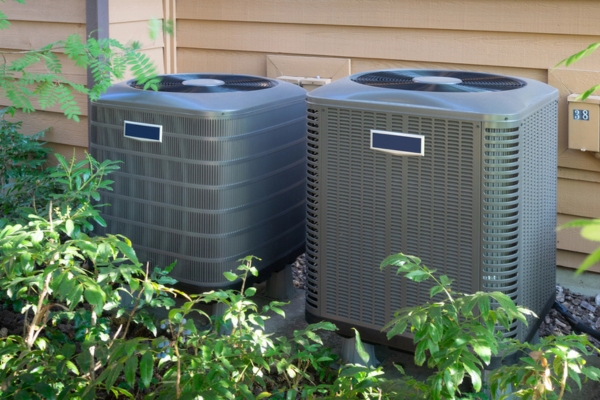Table of Contents
- Understanding How Your Air Conditioner Cools Your Home
- The Standard Cooling Process of an Air Conditioner
- Step 1: The Thermostat Indicates the Need for Cooling
- Step 2: The Refrigerant Absorbs The Heat from Indoors
- Step 3: Fans Blow Cooler Air Back into the House
- Step 4: Heat Within the Coolant is Released Outside
- Step 5: Fans Disperse the Hot Air to the Surroundings
- Step 6: The Cold Refrigerant Cycles Back to the Indoor Unit
- Common Air Conditioner FAQs
- When Should I Consider Replacing My Air Conditioner?
- How Can I Tell If My Air Conditioner Has a Refrigerant Leak?
- What Regular Maintenance Tasks Are Necessary for My Air Conditioner?
- How Often Should I Have My Air Conditioner Serviced by a Professional?
- What Can I Do to Extend My Air Conditioner’s Lifespan?
- Conclusion
- Call Lake Region Energy for All Your HVAC Needs
When the temperature rises indoors, we immediately rely on the air conditioner to bring relief. A simple press of a button can transform our homes into cool, inviting sanctuaries. But how does an air conditioner work? This incredible technology makes the sweltering summer days tolerable, shields us from the risks of heat stroke, and ensures we can rest comfortably through the night.
To earlier civilizations, the precise control of indoor temperatures would have seemed nothing short of magical. Today, however, we understand that the operation of an air conditioner is rooted in the clever application of scientific principles. If you’ve ever been curious about the inner workings of an air conditioner, this article from Lake Region Energy, your trusted local HVAC experts, will provide the answers you seek.
Understanding How Your Air Conditioner Cools Your Home
This article explains how an air conditioner effectively cools your home during the hot summer months.
Critical Components of an Air Conditioner
To understand the cooling process, it’s essential first to understand the main parts of an air conditioner. We’ll focus on four primary components and their functions within the cooling cycle to keep things straightforward:
Air Conditioner Refrigerant

The refrigerant in your air conditioner serves as the system’s lifeblood, playing a critical role in the cooling process. This essential chemical absorbs heat from inside your home and releases it outside. The cooling cycle details the refrigerant’s journey through different components, changing states to perform its cooling duties efficiently. This continuous cycle ensures your air conditioner can maintain a pleasant indoor temperature, even during the peak of summer heat.
AC Unit Evaporator Coils
The evaporator coils are the critical component within the indoor unit that directly interacts with your home environment, absorbing heat from the indoor air. For these coils to operate efficiently, they must remain clean to facilitate effective heat transfer.
Furthermore, the air filters, which capture dust and debris to protect the coils and preserve air quality, must be replaced regularly. Proper maintenance of these components ensures your air conditioner operates effectively and efficiently.
Air Conditioner Condenser Coils

The condenser coils in the outdoor unit are crucial for interacting with the external environment and releasing the heat absorbed from inside your home. Since these coils are exposed to outdoor elements, they can accumulate dirt and debris, impairing efficiency.
Regular cleaning of the condenser coils is vital to maintaining optimal performance and avoiding potential problems. Additionally, scheduling a professional air conditioner tune-up before the summer season ensures the system is thoroughly inspected, cleaned, and ready to manage the increased demand during the hottest months.
Keep your home cool and comfortable with expert air conditioner installation from Lake Region Energy. Schedule your service today!
Cooling System Compressor
The compressor, often called the pump, is an essential refrigeration or air conditioning system element. It is usually situated near the condenser coils. It acts as the system’s heart, driving the refrigerant circulation between the evaporator coils and the condenser coils to facilitate effective heat exchange.
The Standard Cooling Process of an Air Conditioner
Understanding the standard cooling process can help you appreciate how your air conditioner keeps your home comfortable.
Step 1: The Thermostat Indicates the Need for Cooling
After a long day at work, you come home to a house warmer than you’d like. To restore comfort, you turn on the air conditioner and set the thermostat to your preferred temperature.
The thermostat’s sensors continuously monitor the indoor temperature. It triggers the cooling process when it detects that the temperature is above your set level. The compressor activates, sending refrigerant through the system, and the fans start circulating the cool air throughout your home.
Step 2: The Refrigerant Absorbs The Heat from Indoors

The refrigerant’s journey begins at the evaporator coils within the indoor unit, where it is cooled. The refrigerant absorbs the heat as the warm indoor air passes over these cold coils, effectively cooling the air.
In humid conditions, the refrigerant can also cause water vapor in the air to condense into liquid form, thus reducing indoor humidity. This condensed moisture is collected in a tray to prevent it from leaking into the house and potentially damaging the flooring.
Upgrade to a high-efficiency air conditioner with Lake Region Energy and enjoy lower energy bills. Call us for a free estimate!
Step 3: Fans Blow Cooler Air Back into the House
A fan pushes the cold air surrounding the evaporator coils back into the living space. In a central air conditioning system, this cool air is distributed through ducts, ensuring that every room is evenly cooled. In split systems, fans direct the chilled air into specific rooms or zones, allowing individual temperature control based on occupants’ preferences. This setup also provides energy-saving benefits, as you can turn off the indoor unit in a room when it’s not in use.
Step 4: Heat Within the Coolant is Released Outside

Having absorbed as much heat as possible, the refrigerant must travel to the outdoor unit to release this stored warmth. This process occurs through the condenser coils. The refrigerant, being hotter than the outside air, releases heat into the outdoor environment until it reaches a state of equilibrium.
Step 5: Fans Disperse the Hot Air to the Surroundings
Strong fans propel air across the condenser coils to help cool the refrigerant, accelerating heat transfer to the outdoor environment. This process causes the area around the outdoor unit to become noticeably warmer, which you can easily feel by placing your hand near the top of the unit. By placing the unit in an open space, the generated hot air is quickly dispersed by the wind, ensuring that the air conditioner can effectively release indoor heat to the outside continuously.
Ensure your air conditioner runs efficiently all season long with professional maintenance from Lake Region Energy. Book your appointment now!
Step 6: The Cold Refrigerant Cycles Back to the Indoor Unit
After releasing its heat, the refrigerant cools down and is pumped back to the indoor unit by the compressor to begin the cycle again. This cycle persists until the thermostat senses that the indoor temperature has reached the preferred setting, at which point the system pauses. If the indoor temperature rises again, the thermostat will automatically restart the cooling process to maintain a comfortable environment.
Common Air Conditioner FAQs

To help you better understand your air conditioning system, we’ve compiled answers to some of the most frequently asked questions.
When Should I Consider Replacing My Air Conditioner?
If your air conditioner is more than 10-15 years old, frequently breaks down, or requires expensive repairs, you should consider replacing it. Modern units tend to be more energy-efficient and can provide better performance and comfort than older models.
How Can I Tell If My Air Conditioner Has a Refrigerant Leak?
Indicators of a refrigerant leak include diminished cooling effectiveness, ice formation on the evaporator coils, hissing or bubbling sounds near the indoor or outdoor unit, and a noticeable spike in energy bills. If you suspect a leak, it’s advisable to contact a professional HVAC technician for a thorough diagnosis and repair.
What Regular Maintenance Tasks Are Necessary for My Air Conditioner?
To keep your air conditioner running smoothly, you should clean or replace the air filters every 1-3 months to maintain good airflow. Clear any debris and vegetation around the outdoor unit to ensure it operates efficiently.
How Often Should I Have My Air Conditioner Serviced by a Professional?
You should have your air conditioner serviced by an HVAC professional at least once a year, ideally before the cooling season begins. Regular professional maintenance helps identify and fix potential problems early, enhances energy efficiency, and extends the life of your unit.
What Can I Do to Extend My Air Conditioner’s Lifespan?
To prolong the life of your air conditioner, conduct regular maintenance, ensure proper airflow around the outdoor unit, set the thermostat to a moderate temperature to prevent overworking the system, and promptly address any issues or needed repairs.
Conclusion
An air conditioner doesn’t create cold air from anything; it systematically removes heat from the indoor environment, gradually reducing the temperature to meet comfort needs. This ingenious process has proven effective for decades. Modern technological advancements have led to newer models that significantly improve energy efficiency, reducing consumption while enhancing comfort levels for users.
Call Lake Region Energy for All Your HVAC Needs
Lake Region Energy provides top-tier heating and cooling services in Maine and New Hampshire. Our professionally certified technicians are dedicated to delivering exceptional HVAC tune-ups, repairs, installations, and replacements. Each technician has the expertise and experience to efficiently and effectively service your HVAC system.
Lake Region Energy offers the most competitive pricing for heating and cooling services in the area. Our maintenance services elevate your comfort, maximize energy efficiency, and minimize cooling and heating costs. Should you need an HVAC repair or a new system, we can provide the most suitable solutions for your home while staying within your budget. All our work is backed by a satisfaction guarantee. To schedule a service appointment, call Lake Region Energy today. We provide free, in-home estimates.
For more information about our fuel deliveries and HVAC services, be sure to contact Lake Region Energy. You can click here to contact us, or you can call us at (207) 839-5500 to find out more. We offer a full line of heating and cooling repairs, maintenance services, and installations. Click the link to view our service area.

Related Articles:
- Clearing the Air: Preventing Air Conditioner Mold for Healthier Cooling
- Cool Comfort: Architecture’s Evolution With Air Conditioning
- Air Conditioner’s SEER Rating: What You Need to Know
- Clearing the Air: Identifying Air Conditioner Smells Sources
- Reasons Why Your AC Compressor Is Working But Not Cooling
